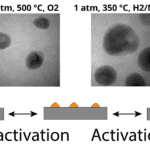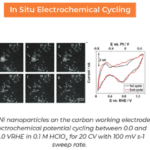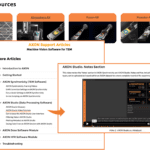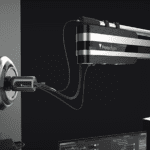
We had the pleasure of interviewing Dr. Kate Marusak Stephens, our Product Applications Engineer based at our headquarters in North Carolina, USA. Over the past few years, Kate has been deeply involved in the testing, refinement, and development of the Triton AX system, as part of the product development team. In this interview, we aimed to gain insights into the development process and explore what the future holds for this exciting new field of research.

What initiated the development of Triton AX?
Projects like these start with market research: having conversations with researchers across a diverse range of expertise over a long period of time. Protochips has always found it important to really sit and listen to the scientific community and let their feedback guide our product roadmap. Over the last few years, there has been consistent feedback that more capabilities were needed for the battery, electrocatalyst, corrosion, and chemistry fields, in order to generate more results that better complement those of bulk scale experiments and real world conditions. For example, in the case of batteries, there is a global effort to scale up electric vehicle usage, however battery performance still leaves a lot to be desired as far as lifetime and capacity. There were countless requests to add temperature to electrochemical experiments, specifically cooling, to replicate cold weather climates. In the case of electrocatalysis, there was a lot of feedback from the field requesting higher temperatures since fuel cells tend to operate at 75°C or higher. From the chemists synthesizing novel nanomaterials, requests for temperatures above 150 °C were prominent to replicate the conditions needed for materials synthesis in organic solvents. It was clear there was an overwhelming need from many areas for a wider temperature range in liquid, and one that could be applied simultaneous to electrochemical studies, to create more relevant conditions for in situ TEM experiments.

When you are developing such unique technology, what steps are taken to prepare for such a large project?
When working on a large project with so much brand-new technology, the process becomes so complex that you have to break it down into manageable steps. This was especially true with the Triton AX project. We were not just focusing on a single function; we had to ensure that three distinct functions worked both independently and simultaneously.
The process began by testing each component individually before gradually integrating them over time. We were already familiar with the nanoscale electrochemistry and heating aspects from our Poseidon AX system—areas where existing technology could be applied. However, the cooling system was a completely new challenge. This raised several questions: How are we gradually decreasing temperature? Which parts of the holder are we cooling? And given that we were increasing the temperature beyond 100 °C, we also needed to investigate chemical compatibility.
Each of these challenges was laid out at the start, allowing us to form a comprehensive plan and timeline. From there, it became a matter of systematically ticking off each test, adjusting as needed, until we had a fully functional system in place.
Were there any challenges that you encountered during development?
During initial testing with prototype systems, we quickly identified a key challenge: crosstalk. Crosstalk is when there is unwanted transfer of electrical signals between communication channels. In this case, it meant the heating was unintentionally affecting the electrochemistry. This discovery forced us to take a closer look at the hardware of the holder, materials of the E-chips, power supplies, etc. requiring us to redevelop certain components. While we had already established solid solutions for other challenges—like drift at lower temperatures—crosstalk was an entirely new and unexplored area for us. Despite the new challenge, we were able to mitigate the effects of crosstalk and now have two well-isolated circuits for heating and electrochemistry.
In addition, with Triton AX, there are now several new pieces of metadata to align and sync within AXON, our data capture and processing software, from many different third-party products. This process required multiple iterations of software development, continuous user feedback, and open communication with the different companies of the third-party products we utilize. This can be a slow process; however, it is a non-negotiable for us to ensure all the parameters and resulting data are recorded and properly aligned with each image in AXON Studio, saving our users a lot of tedious manual data synchronizing, allowing them to actually process and search the data to understand the results of their experiment.
Additionally, we knew chemical compatibility would be another area to focus on. There is a large amount of published chemical compatibility data for materials at room temperature, but very little at elevated temperatures and we saw some of the results of incompatibility with our testing. Unfortunately, we won’t be able to test every possible chemical to provide a comprehensive chemical compatibility chart, so instead we will put that power in the hands of the researchers. We will provide a chemical compatibility testing kit with each system to allow researchers to test their chemicals at the temperature of interest prior to using them in the Triton AX system. The kits will be comprised of swatches of “wetted” materials, or the materials of the holder that will encounter the chemicals used in their individual experiments.
The tip of the Triton AX system looks different than the other closed-cell systems, what was the reason for this?
Honestly, this holder offers significantly more functionality than before. The entire tip was redesigned to accommodate all the new connections and we also implemented some adjustments based on community feedback from over the years. The screws used to close and tighten the lid received a lot of attention. In an effort to make the assembly more glove-box friendly, as requested from our community for air-sensitive and moisture-sensitive samples, the screws no longer have to be fully removed in order to assemble or disassemble the holder tip. Since the screws are so small (as is everything in TEM), it can be very frustrating to drop a screw or accidentally shoot it across the room with your tweezers, and this frustration is even worse in a glovebox.. With the new design for Triton AX, you just loosen and tighten them as needed, and do not need to remove them fully from the holder.
Another piece of feedback from the community regarding the screws was to make them more robust so they don’t need to be replaced frequently. While it was intentional to have the screws originally made from soft brass so as not to strip the holder parts, we understand the desire to replace them less frequently. They are now made of a more robust metal that won’t require as frequent replacement. I have been using the holder 2-3 times a week for 6 months and haven’t had to replace any screws.
Finally, we improved the chemical robustness of the contact scheme between the holder and the E-chips to better prevent accidental corrosion where the E-chips connect to the holder.
Why did the team choose to use a Peltier cooling system instead of liquid nitrogen?
When you look at the target application areas for Triton AX, the goal is not to freeze samples to cryogenic temperatures. Whether the cold temperature is applied to create a more operando style environment, to slow down reaction kinetics, or mitigate electron beam damage, the goal is to have an environment where studying electrochemical processes is possible. Liquid nitrogen temperatures really aren’t necessary here and have some downsides that would not have been ideal for our user-bases experimental needs.
The Peltier cooling system combined with our patented FrameHeaterTM technology gives us complete control over the sample’s temperature through the entire temperature range of -50 °C to 300 °C. Stability at the tip of the holder is also critical, and using Peltier cooling not only provides excellent stability as compared to liquid nitrogen, but also enables extended imaging times, longer than what I understand liquid nitrogen can provide.
From what I understand about cryo-microscopy, there is usually a significant delay in reaching low temperatures, along with the need to wait for the entire holder to stabilize. Our system eliminates that wait, offering a more efficient and controlled process.
In what ways do you see Triton AX altering the in situ TEM landscape?
I believe the energy research field stands to benefit immensely from the integration of cooling, heating, and electrochemistry in in situ systems. These new capabilities will make it far easier to scale bulk experiments down to the nanoscale, with much greater reproducibility. Beyond energy research, this system is also ideal for applications like nanoparticle synthesis. Researchers we have spoken to have highlighted that nanoparticle synthesis typically requires high temperatures and a wide range of liquids, making this system an excellent tool for studying those processes.
In addition to these more ‘obvious’ areas of interest, there are always researchers thinking outside the box. One fascinating field we had not considered when developing Triton AX was freezing of liquids. The precise temperature control offered by the Peltier system allows users to observe the real-time freezing behavior of different liquids, opening new avenues of exploration.
As more researchers adopt this technology, I am eager to see how they push its boundaries and uncover even more innovative applications. There is so much potential in this new method of doing in situ TEM, and I can’t wait to see this system inspire groundbreaking discoveries in fields we may have not even considered.
What type of studies are you hoping to see done first with the Triton AX system?
This is an exciting topic for me because I’m eager to see what our users will investigate! One area I am particularly enthusiastic about is freezing liquids. We have already experimented with freezing water using our standard E-chips and observed a clear confinement effect due to the small volumes of water between the E-chips. I’m curious to see how this changes when users start using our other chip offerings like our microwell E-chips—this could potentially amplify the confinement effect!
Another fascinating area is the intersection of temperature and electrochemistry. How do temperature changes affect the surface of the electrode and the overall experiment? While this might not be a significant issue in bulk experiments, it becomes really intriguing at the nanoscale.
I would also love to see more in-depth studies on the effect of electron dose at different temperatures. We have noticed in our experiments that dose effects can be mitigated to some degree as we cool even though we are not reaching cryogenic temperatures, allowing us to apply more electron flux without altering the sample. It’s something I never thought about before we casually noticed a pattern of less beam damage at cooler temperatures, and I’m really excited to see how this will impact liquid phase microscopy in the future.
These ideas came from just the few experiments we have run so far, just think of what other creative ideas our users will come up with!

Thanks to Kate to share her knowledge and enthusiasm on this new system!
To learn more about this, see the following links:
For the Triton AX main page, click here
Do you want to know what Triton AX consists off? Click here
Want to download the brochure? Click here









